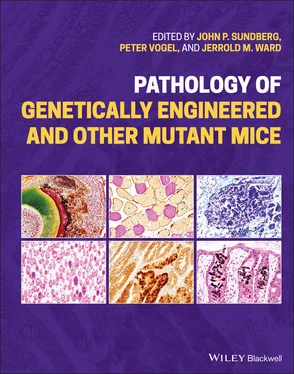Pathology of Genetically Engineered and Other Mutant Mice
Здесь есть возможность читать онлайн «Pathology of Genetically Engineered and Other Mutant Mice» — ознакомительный отрывок электронной книги совершенно бесплатно, а после прочтения отрывка купить полную версию. В некоторых случаях можно слушать аудио, скачать через торрент в формате fb2 и присутствует краткое содержание. Жанр: unrecognised, на английском языке. Описание произведения, (предисловие) а так же отзывы посетителей доступны на портале библиотеки ЛибКат.
- Название:Pathology of Genetically Engineered and Other Mutant Mice
- Автор:
- Жанр:
- Год:неизвестен
- ISBN:нет данных
- Рейтинг книги:3 / 5. Голосов: 1
-
Избранное:Добавить в избранное
- Отзывы:
-
Ваша оценка:
- 60
- 1
- 2
- 3
- 4
- 5
Pathology of Genetically Engineered and Other Mutant Mice: краткое содержание, описание и аннотация
Предлагаем к чтению аннотацию, описание, краткое содержание или предисловие (зависит от того, что написал сам автор книги «Pathology of Genetically Engineered and Other Mutant Mice»). Если вы не нашли необходимую информацию о книге — напишите в комментариях, мы постараемся отыскать её.
An updated and comprehensive reference to pathology in every organ system in genetically modified mice Pathology of Genetically Engineered and Other Mutant Mice
Pathology of Genetically Engineered and Other Mutant Mice
Pathology of Genetically Engineered and Other Mutant Mice — читать онлайн ознакомительный отрывок
Ниже представлен текст книги, разбитый по страницам. Система сохранения места последней прочитанной страницы, позволяет с удобством читать онлайн бесплатно книгу «Pathology of Genetically Engineered and Other Mutant Mice», без необходимости каждый раз заново искать на чём Вы остановились. Поставьте закладку, и сможете в любой момент перейти на страницу, на которой закончили чтение.
Интервал:
Закладка:
The purpose of this book is to provide a broad overview on how pathologists phenotype mutant and wild‐type (without an induced or natural gene mutation) mice and compare them to human diseases. Each chapter covers one organ or organ system with a brief overview of the anatomy, but more importantly, specifics on tissue collection, processing, and special stains or assays used to analyze that particular organ. Each chapter is written by one or more experts on that organ. In so doing, this book provides a useful starting point for investigators working with mice, be they experts or neophytes.
Nomenclature is a critical aspect of pathological description. Pathologists learn to critically utilize very specific medical terms to describe gross and histologic features of lesions and that is evident throughout this book. However, equally important when working with mice, humans, rats, and many other laboratory species, is the species‐specific nomenclature for genes and proteins. Reviews, especially books, should compile information on specific topics to provide an up‐to‐date overview, including using current molecular nomenclature. While this is required by most journals, few editors or reviewers pay much attention to nomenclature accuracy. Because we felt this was such an important and largely overlooked topic, there is a detailed chapter on this subject in this book. The editors made a decided effort to review all chapters not only for accuracy of the pathological descriptions and terms but also for molecular nomenclature. Ultimately, the chapter authors were free to decide whether or not to use the current terms, including listing the specific allelic mutations they were discussing, and most did. We want to specifically thank Michelle Perry, David Shaw, and Dale Begley from the Mouse Genome Informatics Database group at the Jackson Laboratory for following up on all of our inquiries to make sure we did our best to get the nomenclature correct. This included in a number of cases getting new names assigned to mouse mutant alleles that were recently published.
The real value for updating genetic nomenclature became obvious in many of the chapters as they were being reviewed. Defining an animal model of a human disease depends on closely matching the disease features (phenotypes) between the animal under investigation (the mouse) and humans in particular. Over the years, lab names were given to the animals, often indicating something about their phenotype(s). These names became embedded within “the field” to the point they were considered to be standard names. The mouse genetic community many years ago set up the International Committee on Standardized Genetic Nomenclature for Mice ( http://www.informatics.jax.org/mgihome/nomen/inc.shtml). This is housed at the Jackson Laboratory within the Mouse Genome Informatics Database (MGI), but the committee consists of geneticists from around the world. They have sought to regularly review and adjust genetic nomenclature as new information is published on genes, biological pathways, and gene functions. In so doing, names change over the years. MGI maintains this information, which includes reported allelic mutations and links to many of the publications about that mutant mouse line. The surprise that came up consistently in all chapters was that as the mutant gene became known, and the names updated, it was obvious that not only did the mouse model often closely resemble the human disease, but since human genetic nomenclature had followed a similar course with updates in names, in most cases the orthologous gene was mutated in both species, an important point in validating the disease model.
It has been an amazing opportunity to follow the development of mouse models from the earliest days of spontaneous mutations occurring in mouse colonies, induced mutations using radiation or chemical mutagenesis, to the introduction of transgenic technology, then targeted mutagenesis (knock‐out mouse technology), to CRISPR/Cas9, and beyond. Parallel to the advances in molecular technology has been refinement of histopathological approaches beyond H&E and special stained sections to immunofluorescence, immunohistochemistry, in situ hybridization, and transcriptome analysis on organs and now to single cells. Despite all these advances, histopathology will always be a backbone for characterizing the biology and pathology of animals including humans. We have seen refinements on all fronts resulting in excellent models for human diseases for dissecting molecular mechanisms to running preclinical trials. This book reflects the current state of the art in pathology phenotyping of mouse models, and we hope will lay the groundwork for many discoveries yet to come.
1 Introduction to Mouse Pathology
Jerrold M. Ward, Peter Vogel, and John P. Sundberg
The Use of Mice in Medical Research
There has been a large increase in the use of mice in both basic and translational medical research over the past 20 years, as evidenced by the increase in retrievable references using “mice” as a keyword in PubMed from 29 029 publications in 1998 to 79 858 in 2018, and over 1.6 million in the entire PubMed database. Mice have been used for both basic and translational (formerly applied) research. Much of this important work is sponsored by the National Institutes of Health (NIH) in the United States. Mice have been used to study basic biological processes, embryo development, genetic disorders, infectious diseases, degenerative diseases, toxicology, carcinogenesis, and aging, often by organ system or tissue. Many Nobel Prize awardees in Physiology or Medicine have used mice in research leading to their honors. Much of this research has been greatly valued for the training of future scientists, discovery of new diseases, understanding the mechanism of disease in mice and other animals, including humans, and in the treatment and prevention of disease in mice and humans [1–8]. Histopathology may be included in the mouse research, but often it is not, or not by someone trained and competent in pathology [9]. The value of pathology has been proven for diagnosis and understanding normal biology and abnormal biology (pathology) of cells, tissues, and organs in all species. Comparative pathology spans all species of animals. But some investigators do not understand the value of pathology, as a discipline, in experimental studies with mice. This book intends to promote the value of mouse pathology in medical research aimed at the discovery of the causes, prevention, and therapy of diseases in both humans and other animals.
Understanding Diseases Found in Mutant Animals
Naturally occurring and induced changes in genes often result in a specific phenotype at the clinical and histopathological levels. The cause of this phenomenon is that genes have specific functions that play a role in the normal homeostasis of cells, tissues, and organs. A genetically engineered mouse () line represents a tool to investigate the effects resulting from the partial or complete loss of gene function or the gain of normal or abnormal functions. The genes are often found to function in specific cellular organelles and biochemical/molecular pathways important for normal biological functions ( Figure 1.1) [10]. Cells involved in common gene functions can be single cell types in single tissues, multiple cells types in a single tissue, or multiple cells types in multiple tissues. Gene expression can also be induced in specific cells and tissues by normal and abnormal body functions, or by exposure to external factors such as drugs, infectious agents, environmental modifications, and ingested foods.
Mutant mice often exhibit histopathological changes (lesions) in tissues and organs that are associated with gene function, but the ultimate clinical phenotype can be influenced by various factors. Much of the histopathology found in mutant mice is in the usual spectrum of degenerative, inflammatory, proliferative, and neoplastic changes also found in nonmutant mice. Nouvelle lesions do occur commonly in some lines of mutant mice. These include unique developmental changes, cellular morphological changes, patterns of lesions, types of proliferative lesions, and often strain specific cancer types. These may be due to specific naturally occurring mutations (polymorphisms) in genes that can serve as genetic based models for disease. Spontaneous mutants made up the bulk of mouse models until the advent first of radiation and then chemical mutagenesis programs. The spectrum of spontaneous lesions is noted in each organ‐specific chapter. Often the lesions are identical or very similar to those associated human genetic disorders, but they also may vary from human lesions. The genetic background of the mice often plays a role in spontaneous as well as induced disease phenotypes.
Читать дальшеИнтервал:
Закладка:
Похожие книги на «Pathology of Genetically Engineered and Other Mutant Mice»
Представляем Вашему вниманию похожие книги на «Pathology of Genetically Engineered and Other Mutant Mice» списком для выбора. Мы отобрали схожую по названию и смыслу литературу в надежде предоставить читателям больше вариантов отыскать новые, интересные, ещё непрочитанные произведения.
Обсуждение, отзывы о книге «Pathology of Genetically Engineered and Other Mutant Mice» и просто собственные мнения читателей. Оставьте ваши комментарии, напишите, что Вы думаете о произведении, его смысле или главных героях. Укажите что конкретно понравилось, а что нет, и почему Вы так считаете.












